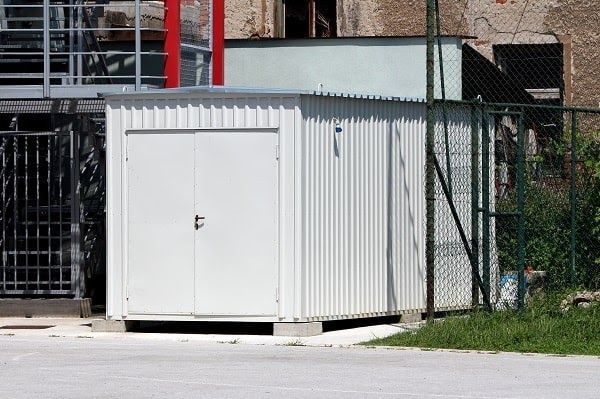- Rent, Lease, or Purchase
- |
June 9, 2021
What is a Shipping Container Shed?


A shipping container shed can completely transform your backyard. It offers functional and versatile space for a variety of uses, such as extra storage, a workshop, or even a personal retreat just a few steps from home (also known as a man cave or the increasingly popular she-shed).
What is a Container Shed?
Repurposed shipping containers are a trending alternative to conventional storage sheds. You can modify steel shipping containers to create a shed for efficient storage space or your personal retreat by the woods.
Why Use Shipping Containers For Sheds?
Wooden storage sheds require constant maintenance. They are immobile, prone to rotting and termites, and have limited room for modifications or rearrangement. Meanwhile, shipping containers are able to withstand harsh weather conditions and rough use. Made of corten steel, these robust structures offer heavy-duty storage space with ample room for modifications.
Shipping Container Shed vs. Metal Shed vs. Wooden Storage Shed- Which Option is Best?
There is an ongoing debate on which is the better option for your backyard storage. Let’s take a look at some specific features:
| Shipping Container | Metal Shed Kit | Wooden Storage Shed | |
|---|---|---|---|
| Set-up Time | <4 Hours | 18+ hours (+10 hours to pour concrete slab) | Construction takes days |
| Security | Extremely Secure | Secure | Secure |
| Mobility | Easy to relocate with a forklift or crane | Permanently placed unless you can disassemble | Permanently placed |
| Longevity | 25+ years | 10+ years | 10+ years |
| Cost | High initial cost | High maintenance cost over the years | High maintenance costs over the years |
| Durability | Highly durable | Durable | Durable |
| Storage Space Availability | High ceiling and sturdy walls offer more storage capacity | Limited space per square foot with only sturdy flooring | Limited space per square foot |
What’s the Best Option?
It boils down to your specific needs. A wooden storage shed may have that rustic charm, but a container-based shed offers more durability, security, and options for modifications. Shipping containers also come in standard 10 ft., 20 ft., and 40 ft. sizes. Metal sheds, meanwhile, may need welding and joining for modifications to meet those specific dimensions.
If you are looking for portability and ample vertical storage space, container-based sheds are the way to go.
Types of Sheds

While you can perform hobbies and DIY projects in containerized workshops, sheds offer the opportunity to create a separate room away from the house that can be used as a fun space, also known as a man cave or she-shed.
A backyard shed is usually a place for storage, but shipping containers are such versatile building blocks, you can convert them into an office, an entertainment space, or a personal hideout. You can use container man caves and she-sheds as your reading or meditation room, a photography, art, or music studio, a sports bar, gym equipment room, hunting gun room, or as an office for business owners.
Of course, you don’t have to rely on containers to create a she-shed or man cave. You can remodel your home to add a she-shed, use available space inside your house, or use prefabricated kit sheds. You can even turn a shipping container into an underground party bunker!
Benefits of Using Shipping Containers as Sheds
Affordable
While not always cheap, shipping containers will cost less than permanent storage solutions in the long run. Converting a used unit does not require lots of materials like wood, brick, or steel. They don’t require expensive maintenance procedures, either. Shipping containers also include sturdy flooring options and strong walls for storage of heavy-duty equipment, which allow them to remain durable over the years.
Quick Delivery and Setup
Installing a container only takes a few hours. Turning it into a shed can take 2-3 weeks compared to brick-and-mortar building construction, which can take months. It is also extremely easy to execute design ideas, doors, windows, and various other modifications.
Secure
A conventional shed is vulnerable to break-ins or damages caused by pests and rodents. Meanwhile, the strength of 14-gauge corten steel, doors secured with a double gasket security seal, and lockboxes can keep burglars at bay and discourage pests and rodents from nibbling their way in.
Portable
One big advantage of a container shed is that you can easily transport it from one place to another. You don't have to dismantle, break down, or even empty it out while shifting or relocating to another property.
Durable
Shipping containers can endure harsh weather conditions and rough use. While a wooden or metal shed is prone to leakage, breakage, dampness, or rotting, a well-ventilated and insulated container increases the lifespan of collectibles, equipment, and other material stored inside.
Things to Consider Before Investing in a Container Shed
Here are a few things customers should consider before investing in a containerized shed:
Delivery of Shipping Containers
You can transport shipping containers on a tilt-bed or roll-off truck or a flatbed truck and place them on the ground using a forklift. The total cost of delivery increases with distance, so look for a reputed, local container provider.
Setting Up the Unit
It is advisable to have some base or foundation for shipping container homes or storage containers. Allowing the unit to sit directly on the ground may affect moisture drainage or ventilation, causing the underside to degrade.
Stacking Containers
Stacking containers offer more room vertically while freeing up space on the ground to add a patio or deck aesthetically. However, before stacking, consider the weight and strength of the structure, capacity to hold, and additional equipment for support.
Cost
Businesses or homeowners looking to invest in shipping container storage sheds must validate the cost according to size (10 ft., 20 ft., 40 ft.), availability (buying or renting), and condition (new, old or slight defects) and identify the right unit within budget.
A reliable supplier will guide you through the pros and cons and offer a suitable unit for your needs. Talk to our experts at 866-459-7600 to learn more.
Tips for Using Space Optimally
To make the most of your container shed, here are a few modification tips:
-
Custom-make doors and windows to allow natural light in
-
Install shelves and racks to store decor items, files, boxes, and other equipment
-
Add partitions to define areas within the shed
-
Ensure proper lighting, air conditioning, telephone, and internet connection in case of an office setup
-
Be sure to attach the unit with drop-down ramps to transfer equipment in and out of the shed
Examples of Modified Shipping Containers
Home Office

Source: Toronto Life
Replacing the front wall with floor-to-ceiling storefront glass windows and doors makes this the perfect spot to work and even sit back and enjoy the garden around. The owners built this modified unit for an HGTV show.
Container Man Cave

Source: Green Retreats
Large, bi-fold doors, a cozy couch, and a pool table to boot, this container garden room is the perfect escape space for kids, and when they are not around the perfect man cave!
She-Shed with Living Roof

Source: Poteet Architects
This unit was initially meant to cater to guests, but it became a lovely she-shed with a few tweaks. Wide windows, wood paneling, beautiful surroundings, and a green roof with plants and flowers make it a cozy spot to retreat to.
Conclusion
The shipping container shed trend is gaining traction and is considered an eco-conscious and budget-friendly alternative to conventional buildings. These units are strong and sturdy built, portability, easy customization, and chic customs designs.
Frequently Asked Questions
Do I need planning permission to put a shipping container on my property?
The process of acquiring planning permission depends on the build and location. When it comes to garden sheds, home offices, garages, you don't need permission if you meet the necessary conditions laid out on the planning portal website. Check with your local authority to be sure.
If you need to place the unit next to a highway or road junction, or it obstructs the neighborhood in any way, you will need planning permission.
Do I need to prep the site before the unit arrives?
Yes, you need to consider these factors for site prep:
-
Is the ground level even and firm?
-
Does the site flood?
-
Is there a strong base to position the shipping container on?
To prevent shifting, consult an experienced supplier and consider securing the unit with concrete footing, railroad ties, asphalt, or gravel.
What is the best foundation to place a container on?
There are four common types of foundations:
-
Pier Foundation - Made of concrete blocks, it's the most common and relatively inexpensive choice.
-
Pile Foundation - Ideal when the soil is too weak to support a concrete base. Not recommended for DIY builders.
-
Slab Foundation - Provides a solid base, especially for a 40 ft. unit when the ground is soft, and you need equal weight distribution. Expensive compared to others as a large area of the land needs to be excavated.
-
Strip Foundation - A combination of pier and slab foundations and is ideal for areas with excess rainfall. Well-suited for small and medium-sized builds.
Related Blogs



Subscribe to Our Blog
Enter your email address to subscribe to the blog and receive the notification of new posts by email.
Thank You for Subscribing to Our Blog!
Stay tuned for upcoming emails with valuable content that we hope will enhance your experience with our brand.
Both Pardot and mg360 form submissions failed.
